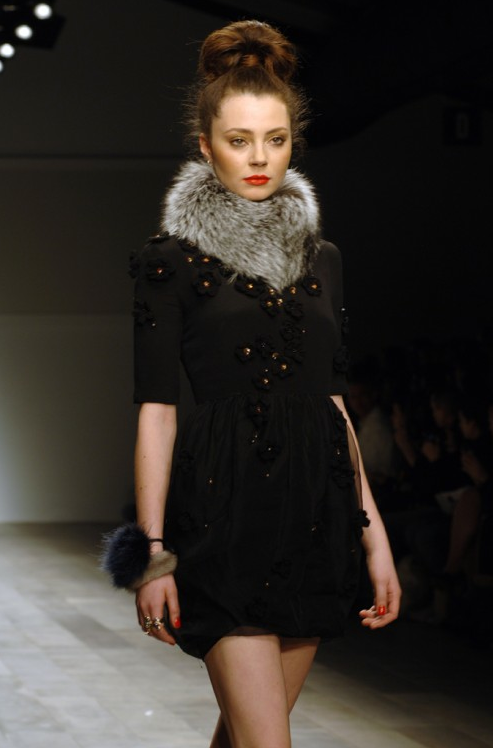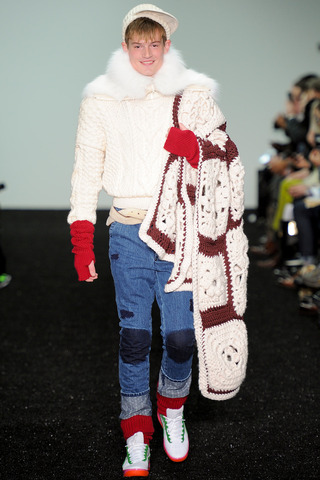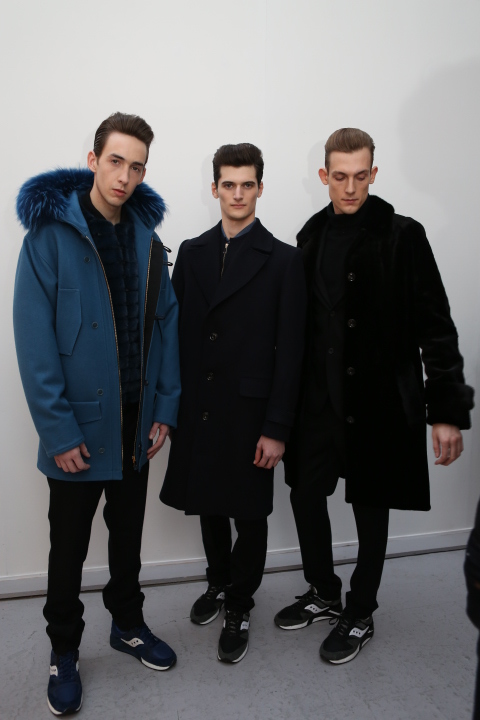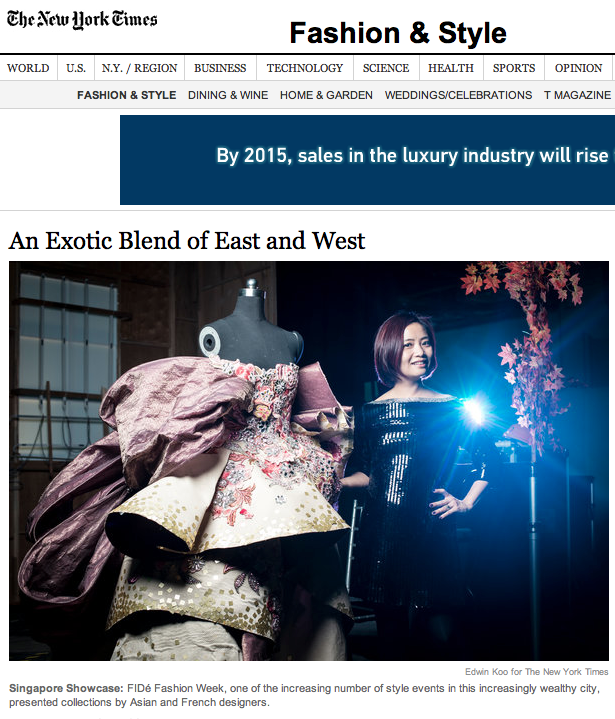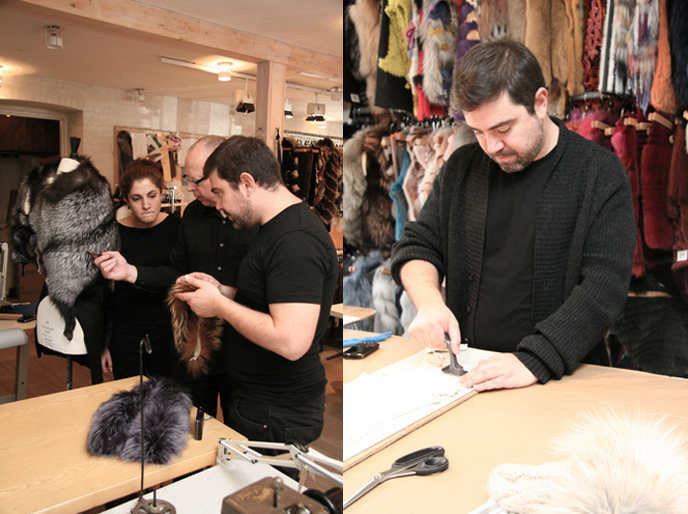Fur is undergoing somewhat of a revival with more and more designers incorporating it into celebrities seizing the opportunity to wear fur for their red carpet appearances. Yet, paradoxically the opposition to fur grows ever more entrenched and strident.
Vodafone London Fashion Weekend
Rebecca Bradley London pieces were used in the London Fashion Weekend shows.
St Andrews Fashion Show
St Andrews Charity Fashion Show is the largest and most successful student run event in the UK.
Our collections Umbra and Blood moon recently featured in the 22nd St Andrews Charity Fashion show, The St Andrews University Charity fashion show is never a dull affair. Pushing the boundaries of what guests expect from a fashion show, the event has raised over £300,000 for worthwhile charities in its 22 year history.
We had a fabulous night, and were very well looked after, and all for a fantastic cause.
The Guardian Fashion Blog
London fashion week autumn/winter 2014 - day two, as it happened
10.13am - The PPQ Show
11.35am - The Emilio de la Morena Show
Style.com - Fall 2014 Menswear Sibling
A Sibling show always requires a certain suspension of disbelief. It wasn't irony—not by a long shot—that Sibling's Cozette McCreery called the Fall show "a love letter in knit from us to all workingmen." Not even when it included drop-crotch sweatpants in hot-pink leopard print. Sibling (comprised of McCreery and partners Joe Bates and Sid Bryan) are too generous to stint themselves for the sake of a theme. You'd never mistake their Fall collection for anything but a Sibling production, but it neverthelesswas visibly and palpably inspired by workingmen, the sort photographed by John Bulmer in his pioneering book The North in the 1960s. There were hardy bits throughout, like patched-up denims, which a man of the mine would need. With them were the kind of homespun heirlooms his devoted wife would be painstakingly making by hand at home, like the crocheted afghans many of the models held.
The Sibling sincerity—occasionally obscured by East End fabulosity that drives the designers to ring Arran knits with Muppet-y fluff—reminded you that their hand-knits are no less hard-wrought or deeply felt than any coal-smeared missus'. Hell, maybemore. Even if the crochet round these parts comes not just in a blanket but also in a short-shorts suit. And if that crochet should snag, just patch it, as the Sibs did here, with bright-green fur.
DAZED - SIBLING AW14
Voluminous knit, coal-black metallics and pimping fur for Sibling"s ode to workingmen
Initial reaction:
Volume, fur, knit…and more volume: Sibling presented a tribe of buff warriors in ceremonious crochet throws, bright fur and Puma sneakers.
How they wore it:
Layers upon layers of merino wool leggings, cardigans, denim jackets and patchwork jeans, topped with mink fur mini capes and thick scarves. Leg warmers were folded over tops of sneakers, and socks were pulled to the knees with shorts. Knitted peaked caps sat high at an angle on the head, a collaboration with milliners Bernstock Speirs.
A midnight black long fur coat, worn over a sequined blue and black bomber jacket with deep elastic waistband, worn over a — wait for it — pale green onesie. Like what Snoop Dogg (sorry, Lion) would wear to take out the dustbins.
The show notes, Sibling said the collection was a “love letter to workingmen”, and colours mimicked an up t’north mining landscape – the black shimmer of coal, grey, berry and arsenic. Leopard print was imagined in shades of maroon, and bright interlinking chain prints looked like knit blown up on a photocopier.
Stand out look:
Metallic black outsized crochet adorning a bright blue fluffy knit, worn over a black sweater with large leather perforated heart – motifs based on lace work and love tokens featured. The final look of metallic midnight grey crochet knit shorts and sweater – and not a lot else – was both intricate and refined.
LCM: Backstage at Baartmans and Siegel AW14
Here’s are some exclusive backstage images from our head photographer Benjamin Glean at the Baartmans and Siegel AW14 presentation which features beautiful craftsmanship and imaginative designs.
The Guardian - London Collections: Men

London Collections: Men ended on Wednesday, concluding the busiest schedule yet. Here are my favourite themes that emerged during the week.
Forest green While black is most definitely back, forest green and charcoal kept the mood sombre but provided slightly gentler, more natural alternatives at the shows this week. Matthew Miller showed deepest forest green to its best advantage on Tuesday but the muted colour was also seen at Oliver Spencer, Common, and YMC.
Bold lines Strong, graphical lines - often scaled up to cover the width of garments - filled runways with moving modernist canvases. Seen at E.Tautz and here at Casely-Hayford but also present at Nicomede Talavera (a designer showing for the first time at talent incubator Fashion East's presentations) and in James Long's strictly futurist collection.
Sometimes the lines crossed and became a check; strongest at Agi & Sam where the oppositional contrast between black and white was maximised in a scaled-up Masai print. Bold checks also appeared at Oliver Spencer and at Casely-Hayford.
Shawls and big scarves This trend was as much evident on attendees as on the runway, with some expert draping on display. At Sibling, the multiple layers involved (all of) crochet, fair isle, fur and fringing, while at E.Tautz the texture was silky, with long fringed evening scarves exposed below jacket hemlines. Overall, whether draped, wrapped or fringed, this sized-up layer brings in a bit of personally arranged randomness. Intimidated? A longer, wider scarf is easier to manage than a full-on blanket shawl.
Texture and surface If there was one overriding shift in direction from last season it's the move away from pure sportiness, with an almost fin de siècle attention given to surface detail and considered luxury and embellishment.
This included embroidery at E.Tautz and Baartmans and Siegel (whose collection also included shaved and paneled fur and extravagant collars offsetting tailoring in airforce blues).
Jacquards appeared at Kit Neale (a designer better known for his prints) and in some surprisingly fashion-y oversized sweaters at Nicole Farhi.
Super-texturised fabrics at James Long and Matthew Miller invited touch, as did slinky astrakhan at Astrid Andersen.
Alternatives to laces As ever, winter footwear was a crucial component to the looks for next year's inclement season. Alternatives to laces were prevalent, like the industrial strap fastening at Nicole Farhi and the zipped shoes at YMC. More irresistable still were the shoes by newcomer Diego Vanassibara, featuring details of highly-polished, wooden lacquerware.
Shoes continue to be hefty and inspired by military styles and workwear, as seen at Lou Dalton, where a collaborative boot with Grenson complimented worker inspired styles in luxury fabrics.
In terms of presentation, gothic London is still ever-present. At E.Tautz models emerged from the darkness as sinister, hyper-elegant fops, stepped out from the literal mist at Baartmans and Siegel like missing airmen and prowled rainy streets at Topman Design.
The "I missed the memo" street trend of the week belongs to cossack and central Asian hats, which were everywhere.
The soundtrack of the week for me was at Matthew Miller, where the James Murphy remix of David Bowie's Love is Lost somehow underlined the modernity of the collection, though Sibling's high-energy mix (including PiL's This Is Not A Love Song) was similarly energised.
The New York Times
SINGAPORE — The backdrop was a Parisian boulevard, and the catwalk was lined with fake trees in autumnal colors. But the electricity in the air was all Singapore.
FIDé Fashion Week 2013, presented by the Shoppes at Marina Bay Sands, displayed the work of 10 Asian and four French designers over an 11-day schedule in mid-October. Frank Cintamani, chairman and founder of the three-year-old event, says he has created Asia’s only complete fashion event, with shows displaying men’s and women’s ready-to-wear as well as couture. And the week’s atmosphere is very different from that found at other fashion gatherings, Mr. Cintamani stressed. Elsewhere, he said, “You don’t get other designers sitting in the front row, supporting one another. You don’t get them going to the back room, helping them hem a dress two minutes before the show starts.”
According to Forbes.com, Singapore is now the world’s fastest growing wealth hub, and fashion is taking advantage. In addition to the FIDé week, the city-state also is host to the Audi Fashion Festival, which marked its fifth year in May, and Digital Fashion Week, a live-streamed event in early November that allows immediate online purchasing.
The FIDé week offered five men’s and four women’s prêt-à-porter shows, among them a one-hour presentation by Guo Pei, one of China’s best-known designers.
She said her “1002 Nights” collection was inspired by the tales in “The Arabian Nights” and a trip to Iran that left her in awe of its culture and history. One style was a short, sculptural purple dress with a green bodice, styled with sharp rings, necklaces and high platform shoes — representing, the designer said, the courage, personality and fearlessness of youth.
Even in rehearsal it was fascinating to watch the models pose on the 15-centimeter, or six-inch, platforms. Huang Chao Yan, a Chinese model, said: “It’s hard to balance. They are not a flat surface, and they move, so it’s difficult not to knock them together and hard to make them walk in a straight line.” Ms. Pei said the shoes reflected the shapes used in the Qing dynasty, which began in the mid-17th century. “The high heel in China is in the middle of the foot, not like on the heel in the Western way,” she explained.
A heavy kimono of rich greens, purples and golds was complimented by a geisha-style makeup designed by Romero Jennings, the makeup-artistry director at the MAC cosmetics company. It included long red eyelashes that he fashioned out of a metallic contact paper found in Korea.
Ms. Pei clearly loves her work, noting that “couture is very open. It touches people’s hearts. It’s an incredible art.”The Beijing designer noted that when she began her label in the 1980s, “no one knew traditional Chinese embroidery.” Now, she said, she employs 450 artisans, she has trained herself because “memories and skills have gone.”
Michael Cinco, a Filipino designer in Dubai, said he was inspired by matadors and flamenco dancers, the Alhambra Palace in Granada and the Alba Flamenca restaurant in Edinburgh. “Most of my collection is in reds, shades of reds; layers and layers of lace; blacks and beige,” the designer said from behind his trademark hide-the-eyes shades. His outfits included a matador-style jacket with sequin tassels, a blood-red lace cape, and a long beige dress with a high neck and long sleeves that had lace, tulle and crystal detailing. Mr. Cinco, whose clients include Lady Gaga and the Colombian actress Sofia Vergara, said he loved working with tulle “because I can put a different kind of provocation with a lot of details on it, and Swarovski crystals give drama, poetry and emotion to the wearer.”
The Indonesian designer Sebastian Gunawan’s “Mod Muse” show rocked to a riotous soundtrack that included music by the Rolling Stones, the Clash and the Sex Pistols. “Music works with the clothes to create and follow what modern women are,” he said. But, the designer added, “part of my dream is seeing when women feel like princesses, too” — like any women would in his beaded and embroidered long gown of midnight blue raw silk.
Yumi Katsura, one of Japan’s most prolific designers, surprised the audience with a short puff dress — embellished with Swarovski crystals running down the shoulders, arms and legs — that, with a pull on a ribbon, cascaded into a long gown.
And Lie Sang Bong, considered one of the most influential couturiers in South Korea, described his collection as “flowers blossoming explosively, like fireworks in a city.” He featured 1960s swirly print A-line dresses, mostly in black and white silk, which were set off by the models’ black nails.
Kenzo Takada, founder of the Kenzo fashion house, observed the Japanese designers: Junko Koshino’s dramatic capes, Yoshiki Hishinuma’s handpainted flora and fauna motifs on silks and chiffons, and Keita Maruyama’s ’50s skirts and a green and white dress with green bows racing down the back.
The French Couture evening, a highlight of the event, featured the Paris designers Alexis Mabille and Julien Fournié and the French label On Aura Vu Tout.
Mr. Fournié showed both his autumn 2013 couture line and a capsule collection, Julien Fournié for Love Bonito, created for the online store founded in Singapore by Rachel Lim and Viola Tan. His couture “First Chimera” collection was inspired by American comics and superheroines, with what the designer called “a mix and match between woman, lion and mermaid.” Mr. Fournié said his obsession, along with the zippered hem, is “how to elongate the body as the famous artist Modigliani” did and noted that the muted chocolate palette was inspired by the colors of the painter Gustav Klimt. One style: 33 mink pelts stitched onto an organza ribbon by Rebecca Bradley, the London furrier, to create a mink dress.
In contrast, the capsule collection lured the Love Bonito girl with a riot of color — purples, apple green, fuchsia and yellow — as well as Mr. Fournié’s funky zipper hems.
At the conclusion, the designer and his Love Bonito collaborators danced down the catwalk hand-in-hand as glittering confetti rained down — something of a metaphor for the entire fashion week.
Finnish Saga furs enters in a partnership with the Bolshoi Theatre
Saga Furs has entered a partnership with the Bolshoi Theatre to provide the furs and technical assistance for the spectacular stage costumes to be used in the esteemed institution's first production of Strauss' Die Fledermaus. Celebrated Russian designer Igor Chapurin has been invited to create the stunning costumes.
Russian designer Igor Chapurin has designed an impressive all-white fur wardrobe for Strauss’ Die Fledermaus operetta staged at the Bolshoi Theatre in Moscow. The international fur auction company Finnish Fur Sales donated Finnish specialty products, such as Arctic Marble and Shadow Fox skins, for costume material. The company has exclusive global rights to the Saga® trade mark which, in addition to serving as a guarantee for the technical quality of fox, mink, and Finnraccoon skins, also is a guarantee for responsible animal breeding. The collection designed by Chapurin is seen during the second act of the operetta. On Friday, also invited guests from Finland will attend the performance.



The idea for Die Fledermaus operetta’s wardrobe came from the Bolshoi Theatre’s Public Relations Director, who knows Chapurin and has collaborated with Saga Furs since 1998. Saga Furs is in charge of Finnish Fur Sales’ fur pelt product development.
As the project’s format started to develop, Annette Traberg, a furrier at Saga’s design workshop located in Vedbaek, Denmark, and Rebecca Bradley, a fur professional from London, joined in the practical work. To facilitate the implementation of similar projects also in the future, the partners donated to the Bolshoi Theatre the machine required to work the fur material.
Sculpting fur into fashion
Emilio de la Morena will now try his hand at fur after the collections he has shown at London Fashion Week have grabbed loads of attention. The London-based Spanish designer attended a seminar at Saga Furs Design Centre to get started with fur.
Colour, silhouette and structure sparked interest in Emilio de la Morena’s collections for women. His dresses ooze with a feminine appeal that is fresh and young. “I show in London and London is very young,” he says. “I am more to the feminine, chic, almost Parisian, but I can still show in London, so it just makes sense to use fur. Fur is a beautiful product, luxurious, and I’ve always had an inclination to use it.”
Ethics was a prime factor in Morena’s decision to work with Saga Furs. “If I’m going to use fur, I’m going to get it from a trusted source. Saga Furs has a good campaign—I did my research,” he says. “It’s a brand I trust. I had heard about Saga Furs and read about policies and concluded that what they do is correct. And it’s a profitable brand, one that’s good to be associated with.”
A helping and experienced hand
London fur consultant Rebecca Bradley accompanied Morena to Saga Furs Design Centre where she helped him search for the right look.
Through friends and friends of friends, the two first met backstage at London Fashion Week where they chatted about ideas. Saga Furs had been in contact with Morena and Bradley—who handles fur tasks for a number of designers--had previously visited Saga Furs Design Centre, so fur became a natural topic of conversation. After chatting for a while, the potential for a future bond became quite obvious: Morena wanted to work with fur and Bradley is an experienced furrier who could help him.
Exploring, experimenting to find the extra dimension
Morena and Bradley approached fur from a structural point of view. “This is about exploration, to find something that goes with what I do: modern, graphic, understated,” the designer says. “I want it to look natural, architectural, structural.”
“He knows where he’s going, and I know where he’s going,” Bradley says, and Morena confirms the mental connection with a nod. They both attempt to describe with hand gestures where they are headed, but punctuate the attempt with a chuckle. “It’s still abstract, but when we get it we will know,” Morena declares, and Bradley adds: “Basically, we need to go from point A to point B and we’re somewhere in between.”
Building the aesthetic
Morena studied at Central St. Martins and London College of Fashion, and worked for Rafael Lopez and Jonathan Saunders before launching his own line. With a look that is young and chic, Morena quickly grabbed the spotlight after just a couple of seasons. A dress he created is part of a permanent display at Museu Textile Indumentaria de Barcelona.
“I studied sculpture and am used to working with clay or plastic, but I am terrible at drawing. So I mostly work on a mannequin and play with the fabric in three dimensions,” says Morena.
“When you drape the material, you understand it more,” notes Bradley. “How can pen and paper give you the right idea?”
The duo bounced a number of different ideas off one another while working with swatches of fur. “I’m not sure about a whole garment, but maybe. And maybe applications and utilitarian use of fur will be the way to go,” he says. “Getting help from the staff here, it’s interesting to learn about the qualities and types of fur, the colours and textures.”
Personal spin on luxurious fur
With endless possibilities for creating fashion from fur, Bradley and Moreno zeroed in on a few specific techniques that may feature in future collections. “I want to make something special, something standout and fresh,” he says, and Bradley comments: “But not showy.” Morena considers this for a second and adds: “Maybe a little showy, but not just a show piece, not one that’s noisy, rather something wearable and fur works so perfectly.”
Morena’s original idea was to explore the spectrum of colours available in fur, “but the more I learn about fur, the more I realize this is not necessary.”
One idea the two will probably pursue is choosing different materials and mixing them. “That’s my idea with fur. I know it’s been done before, but I plan to put my personal taste into it,” he says.
Nicholas Oakwell

Refreshing British couture tradition
London-based Nicholas Oakwell wants to renew and strengthen couture in the UK. Inspiration and knowledge gathered at Saga Furs Design Centre will help him incorporate more fur into a collection he will show in London this June.
Couture has long been a British tradition, though the much of the talent has been pushed into the shadows in the past couple of decades. Nicholas Oakwell intends to change that, although finding the right talent was not simply a question of finding a number in the phone book.
“I’ve been lucky in putting my team together,” he says, and tells how it was necessary to sort through 30 different craftswomen before finding one who was expert at a the particular craft he needs. “They are out there, but they’re not using their abilities.”
Adding more fur to the mix
At Saga Furs Design Centre, Oakwell did preliminary work on pieces that will feature in his London show this June. His previous outings have demonstrated a flair for materials, so feathers, leather and fur will likely play central roles in a contemporary, edgy and light look.
“You can use fur in such a light way, for instance with chiffon,” he says. “Techniques for making fur trim, embroidery, can be fascinating.”
Nicholas Oakwell worked as a milliner and has done stints with Dior, Katharine Hamnett, Amanda Wakely and others before founding his own label in 2011. As London is a world shopping centre, he has attracted clients from China, Russia, the Middle East and of course well-heeled domestic customers.
Pushing British craftsmanship
One pair of deft hands Oakwell recruited for his team belong to London furrier Rebecca Bradley who worked on fur items for an earlier collection. “I didn’t really get into how it was all done, and then I came here, and Ooooh!” he says, astonished at all that can be done with fur.
“I had some basic ideas for three or four pieces, but being here and seeing the techniques—now I’m thinking more. One idea is a print on shorn mink to achieve a tweed texture, a tweed jacket in fur.”
Oakwell wants all craft processes in the UK where his team is based. “When I design, it’s like being the conductor of an orchestra. I guide them so it fits together, the trombone with the drum with the oboe …”
Chinese media get inside view of fur fashion in the making

Fur on the runway is breathtaking, but a group of Chinese journalists from Harper’s Bazaar and Beijing TV visited Saga Furs Design Centre to get a behind the scenes view of where and how fur creations start. As the pioneer in taking fur to new levels and CSR values, Saga Furs was the obvious choice for them. Their Nordic trip included a leg in Helsinki for a photo shoot and visit to Finnish Fur Sales. The charms of Nordic summer, with its long days and fresh sea breezes, provided the ideal atmosphere for a group of Chinese journalists who wanted to delve into the secrets of fur at Saga Furs Design Centre. They found a new world of creation and got the opportunity to interview a couple of top designers who were at the Centre to find inspiration for upcoming collections.
“Fur is very very much in fashion, so these journalists are obviously keen to learn more so they can bring their audiences a broader picture of how fur fashion is created,” says Saga Furs regional manager (Asia) Nora Tse, who accompanied the group. “They are very interested in fur and of course they recognize the Saga Furs brand for its superior quality and values of responsibility, so now they are here. For them it is a working assignment, but I can see how fascinated they are by all the fur techniques they see here.”
The group consisted of: Ms. Chen Menghan, fashion editor of Harper’s Bazaar; and, from Beijing TV Ms. Qian Dandan, producer; MS. Qi Fang, TV show host; and their cameraman Mr. Ma Yongjie.
The reporters buzzed around Saga Furs Design Centre to capture the atmosphere of the site. They spent a lot of time in the Workshop, viewing various fur techniques, learning about different types of fur, and understanding the vast potential of fur as a material.
Fur fashion in the making
The media representatives took fur-technique samples and various types of fur as props for photo situations while they spoke with the Workshop staff to gain knowledge about what they were doing. The staff members were engaged in daily routines that involve preparing sample swatches and helping two designers and their companions who were visiting Saga Furs Design Centre simultaneously with the media group.
The designers were at the Centre to get ideas for upcoming collections. Manish Arora, a Parisian designer who hails from India, was back at Saga Furs for a second time to gather some preliminary impressions for his A-W 2012-12 collection. He had attended a seminar at the start of the year to make pieces for the past fashion week season. Arora’s fur fashions were major hits in Paris, especially a colourful coat using the intarsia technique. The Chinese journalists interviewed him about his craft, and a slew of pictures of the stunning coat were taken.
The other designer who will be the subject of both media’s reportage was Emilio de la Morena, a London-based Spanish designer who has gained huge popularity the past few seasons. Morena is a newcomer to fur, but was accompanied by fur consultant Rebecca Bradley, who will help him realize his visions in fur.
The press teams watched—and did their reporting assignments--as the designers examined materials and did some hands-on experimenting with fur. The Workshop setting provided some colourful vignettes of fur fashion in the making as well as a vivid picture of people who make fashion at work. Chinese audiences interested in fashion can look forward to the final results of both the reporters and the designers.



